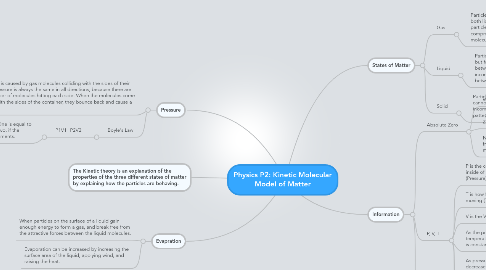
1. The Kinetic theory is an explanation of the properties of the three different states of matter by explaining how the particles are behaving.
2. Evapration
2.1. When particles on the surface of a liquid gain enough energy to form a gas, and break free from the attractive forces between the liquid molecules.
2.2. Evaporation can be increased by increasing the surface area of the liquid, applying wind, and raising the heat.
3. Pressure
3.1. (Gas) Pressure is caused by gas molecules colliding with the sides of their containers. Pressure is always the same in all directions, because there are an equal number of molecules hitting each side. When the molecules come into contact with the sides of the container, they bounce back and cause a force.
3.2. Boyle's Law
3.2.1. P1V1=P2V2
3.2.1.1. Pressure One Multiplied by Volume One is equal to Pressure Two Multiplied by Volume Two, if the amount of gas is equal in both experiments.
4. States of Matter
4.1. Gas
4.1.1. Particles far apart from each other, and move around freely. Warmer than both liquids and solids of the same substance, and bonds between the particles are not present. Can fill almost any shape, because they are compressable, and don't have a fixed volume. No force, except when the molecules collide.
4.2. Liquid
4.2.1. Particles tightly packed, but can slide around each other. Still aslo vibrating, but faster than particles in a solid. Generally warmer than a solid, the bonds between the particles aren't as strong, so the bonds can shift around. Still incompressible, and have a fixed volume, but no fixed shape. Weak forces between molecules
4.3. Solid
4.3.1. Particles tightly packed, and bonded together. Still vibrating, but cannot adapt to the container that they are in. They are incompressible, have a fixed volume, and a fixed shape. Regular pattern. Strong forces between molecules
5. Information
5.1. Absolute Zero
5.1.1. When molecules no longer shake or move.
5.1.2. -273 Degrees Centigrade, and Zero Degrees Kelvin.
5.1.3. No more energy can be extracted from molecules making up matter.
5.2. P, V, T
5.2.1. P is the collisions with the inside of the container (Pressure)
5.2.2. T is how fast the particles are moving (Temperature)
5.2.3. V is the Volume of the container
5.2.4. As the pressure and temperature go up, the volume is constant.
5.2.5. As pressure increases and the volume decreases, the temperature must be constant.
5.2.6. Ask Mr. Ware about the highlighted things on back page.

